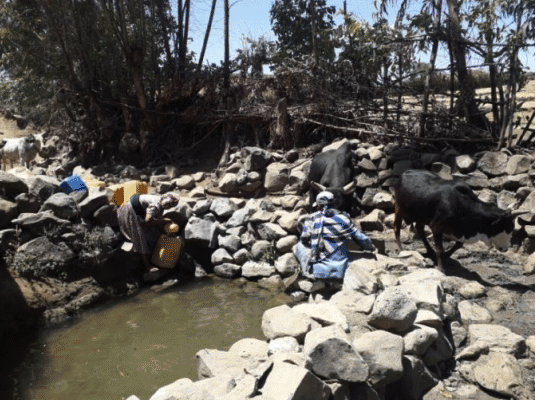Ethiopia
Mutti (Amhara Region)
In honor of the founder of the WaterFoundation Henner Lang, who died in 2021 as a result of a corona infection, two water supply sites are being built in his beloved Ethiopia, one in the village of Mutti (Amhara region) and a second in the community of Ambacho (Oromia region).
Background
Only 57% of the population in Ethiopia have regular access to clean water. People in the project area have to travel long distances to fetch water from unsafe water sources. Because animals also use these sources, disease transmission is common. It is estimated that 60% to 80% of communicable diseases and 50% of cases of malnutrition in Ethiopia are due to limited access to clean water and sanitation.
Women and girls are typically responsible for carrying water in heavy jerry cans on their backs, which is physically demanding and also limits their ability to participate in community events and school.
Although the community is well motivated and organized, it is beyond their financial and technical capacity to carry out the work to ensure access to clean water without assistance.
Our local partner – the Environmentalists Development Association – Ethiopia (EDA-E) has implemented various projects in 14 localities of Basona Werana district since 2009. Cooperation with the communities and local authorities has been consistently intensive and successful. Because all sites are supported by the WasserStiftung, Henner Lang has personally visited the area several times.
Project site
The settlement of Mutti belongs to the administrative unit Nas in the district of Basona Weran. This belongs to the North Showa area in the Amhara region. Mutti is located 175 km northeast of the capital Addis Ababa at an altitude of 2618 meters. The village is accessible by car. Most of the way is on a paved road to Dessie and Mekele. The remaining 15 km to Mutti are on a country road with partly very steep passes.
Project beneficiaries
The local people are very motivated to actively participate in the project development and implementation. All earthworks are carried out by community members. In addition, a water committee is formed in advance, and its members receive appropriate training to ensure the sustainable operation of the water supply system. The community also provides the materials for fencing the project site.
Direct beneficiaries of the project are 100 households with a good 600 people. In addition, there are 500 cattle, 1500 sheep and goats, and 150 donkeys.
Project activities
For the development and capping of the spring, the source of the spring water is first identified. Earth is then excavated until impermeable soil or rock is reached. The excavation area will be covered with concrete walls and a poured concrete floor, and the surrounding area will be cleared. The area around the spring will be backfilled with rocks and gravel. The entire area will then be covered with a concrete slab, leaving a manhole cover for cleaning and inspection of the spring box. At least three metal pipes are inserted into the concrete outer wall to serve as drain, waste and overflow lines. Depending on the type and size of the spring, a vent pipe may also be installed. Finally, a retaining wall is constructed to protect the spring from flooding.
A masonry wall with concrete base and top slabs will be built on a solid foundation to store about 4 m3 of water in the tank. This water tank will serve as a water intake point for the community.
People in the village rely on domestic animals, so it is important to ensure that their water needs are also taken care of. A livestock trough allows the animals to have relatively clean water on site and not only saves them from thirst, but also from parasites such as leeches that are common in the area.
Supporters
Many private donors who are building the water supply facility in memory of Henner Lang.
Project costs
5.500 Euro
Project period
April until July 2022
